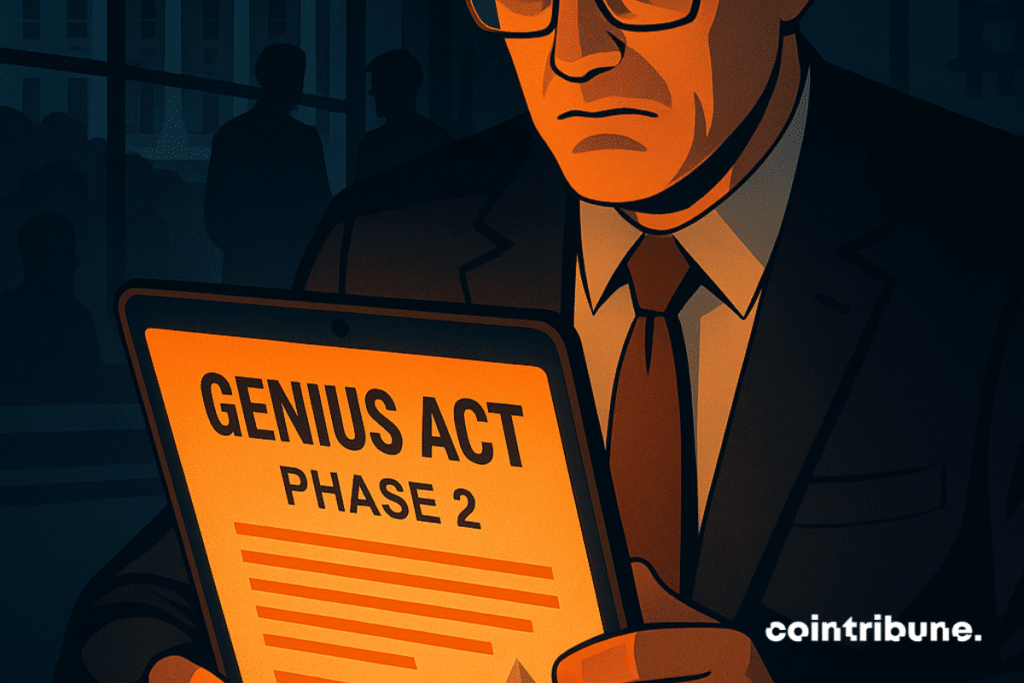Crypto : The US Treasury launches a second consultation phase on the GENIUS Act
Washington goes back to the drawing board. The US Treasury opens a new comment window to transform the GENIUS Act, the future framework law on payment stablecoins, into applicable rules. The stated objective? To secure the use of tokenized dollars while maintaining a workable playground for crypto innovation. Let’s get into the specifics.

In brief
- Washington opens a second consultation to apply the GENIUS Act to stablecoins governing issuers, reserves, extraterritorial scope, sanctions.
- Enhanced transparency with monthly reports on reserves, liquidity control, and withdrawal of unauthorized stablecoins by providers.
- Entry into force expected at the end of 2026 while the Senate clarifies SEC, CFTC, and favors predictable rules.
What Washington exactly wants to regulate in crypto
The Treasury is seeking opinions on who can issue a payment stablecoin in the United States, how to hold reserves, as well as the extraterritorial scope of the requirements when a token is offered to US residents from abroad. The scope also includes interoperability, sanctions, anti-money laundering, and taxation. The questionnaire is deliberately broad to capture operational feedback.
An interagency committee, the Stablecoin Certification Review Committee, must evaluate if a state regime is substantially similar to the federal framework. This point remains key for locally regulated crypto issuers aiming for national recognition. In short, the arbitration between federal supervision and state supervision is clearly stated.
The text provides for monthly publication obligations on reserve composition and liquidity risk control. Providers operating in the United States will have to stop distributing stablecoins issued by non-permitted entities after a transition period. Limited exemptions and tolerance margins may exist, but they will depend precisely on the responses to the consultation.
A timeline pushing towards 2026 and already preparing 2028
The policymakers started this summer for the crypto framework. The government enacted the crypto law and is waiting for the Treasury and the Federal Reserve to define its regulatory implementation. The application will occur eighteen months after enactment or one hundred twenty days after the finalization of the rules, whichever comes first. Barring administrative acceleration, the crypto framework is thus expected to take effect no earlier than late 2026.
This phasing provides visibility to issuers. They can adjust governance, liquidity management, and insurance mechanisms. They must also simulate different reserve asset mixes and prepare more frequent and clearer reports. Best practice is to test crisis scenarios and document redemption capacity under all circumstances.
Beyond that, an already apparent deadline emerges for US providers. From a medium-term deadline, they will no longer be able to offer stablecoins that do not comply with the permitted issuer regime. This creates a strong incentive to migrate to compatible standards, with recurring attestations and refined risk management.
Market: the Senate refines the structure while the Treasury settles the details
Meanwhile, the Senate is advancing on a broader market structure. A framework project aims to clarify the role-sharing between the SEC and the CFTC, to specify platform obligations, and better define the boundary between payment tokens and traded assets. Republican leaders are pushing for a committee vote in the short term, with a legislative trajectory over the 2025-2026 period.
This effort complements the GENIUS Act. On one side, it regulates tokenized money and its financial security. On the other, it structures trading activity and investor protection. For companies, this means two parallel compliance paths that will have to fit together smoothly.
Practical consequence: less regulation through enforcement actions and more regulation through rules. Serious actors gain a predictable framework, while risky practices become isolated.
Like in Asia, where Beijing toughens its stance on stablecoins while Hong Kong bets on regulating issuers, clarity of expectations becomes a competitive advantage. Competitiveness will then be played out on execution quality, reserve transparency, and the ability to offer faster and cheaper payments.
Maximize your Cointribune experience with our "Read to Earn" program! For every article you read, earn points and access exclusive rewards. Sign up now and start earning benefits.

Fascinated by Bitcoin since 2017, Evariste has continuously researched the subject. While his initial interest was in trading, he now actively seeks to understand all advances centered on cryptocurrencies. As an editor, he strives to consistently deliver high-quality work that reflects the state of the sector as a whole.
The views, thoughts, and opinions expressed in this article belong solely to the author, and should not be taken as investment advice. Do your own research before taking any investment decisions.